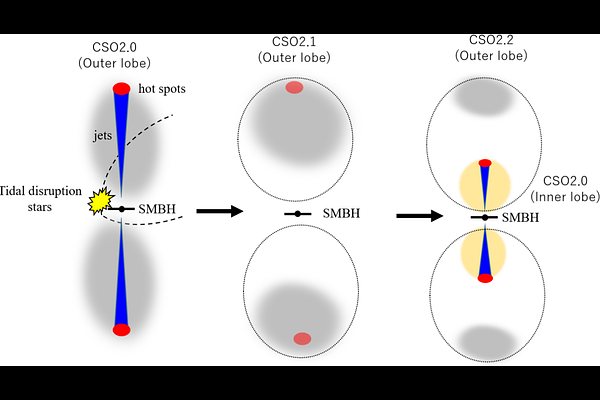On the origin of short-lived cocoon in 3C84: powered by tidal disruption events ?

On the origin of short-lived cocoon in 3C84: powered by tidal disruption events ?
Nozomu Kawakatu, Motoki Kino, Keiichi Wada
AbstractWe evaluated the jet power and the density of ambient matter in 3C 84 by using the momentum balance along the jet axis and the transonic condition for the cocoons observed at two different scales (approximately 1 and 6 parsec scales). For the inner cocoon, we precisely determined the ratio of jet power to ambient density $L_{\rm j}/n_{\rm a}$ to be $(0.3-0.7)\times 10^{43}\,{\rm erg}\,{\rm s}^{-1}\,{\rm cm}^3$. Similarly, for the outer cocoon, we found that this value is more than an order of magnitude larger at $(0.9-3.7)\times 10^{44}\,{\rm erg}\,{\rm s}^{-1}\,{\rm cm}^3$. This indicates that the outer cocoon is formed by a powerful jet that propagates through an ambient density of $20-300\,{\rm cm}^{-3}$ with a jet power of $10^{45-46.5}\,{\rm erg}\,{\rm s}^{-1}$. On the other hand, the inner cocoon is formed by a weaker jet with a power of $10^{43-44}\,{\rm erg}\,{\rm s}^{-1}$, propagating through a relatively low-density environment of $6-20\, {\rm cm}^{-3}$. These results suggest that: 1) with respect to the difference in $n_{\rm a}$, it appears to support the hypothesis that the inner cocoon, recently formed about 10 years ago, is expanding in the low-density cocoon created by the jet emitted about 25-50 years ago. 2) to achieve the short-lived and high $L_{\rm j}$ that generated the outer cocoon, a large mass accretion rate must be required over a short period to activate the jet. These may imply the extreme accretion event driven by the tidal disruption events (TDEs) of massive stars and/or the disk instability.